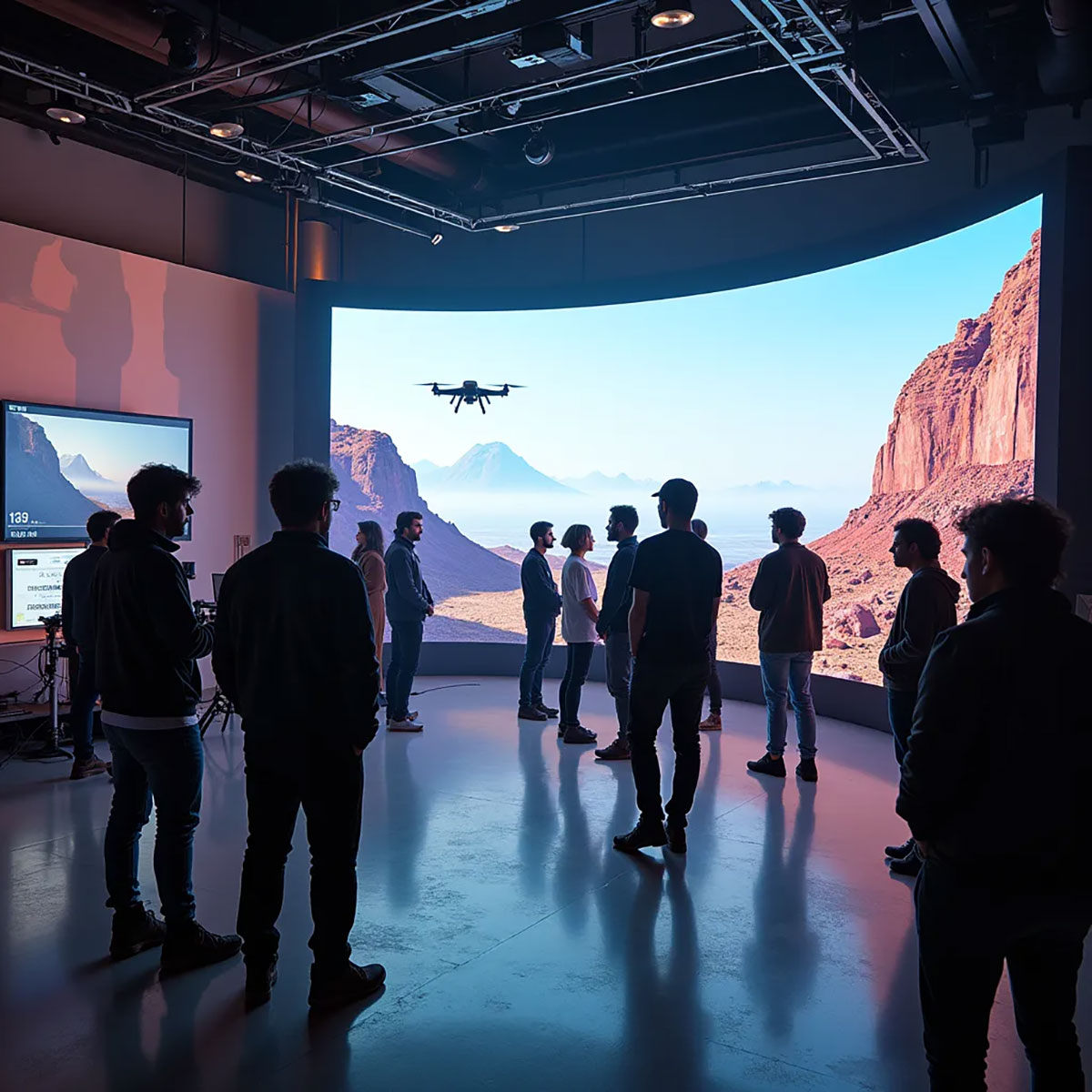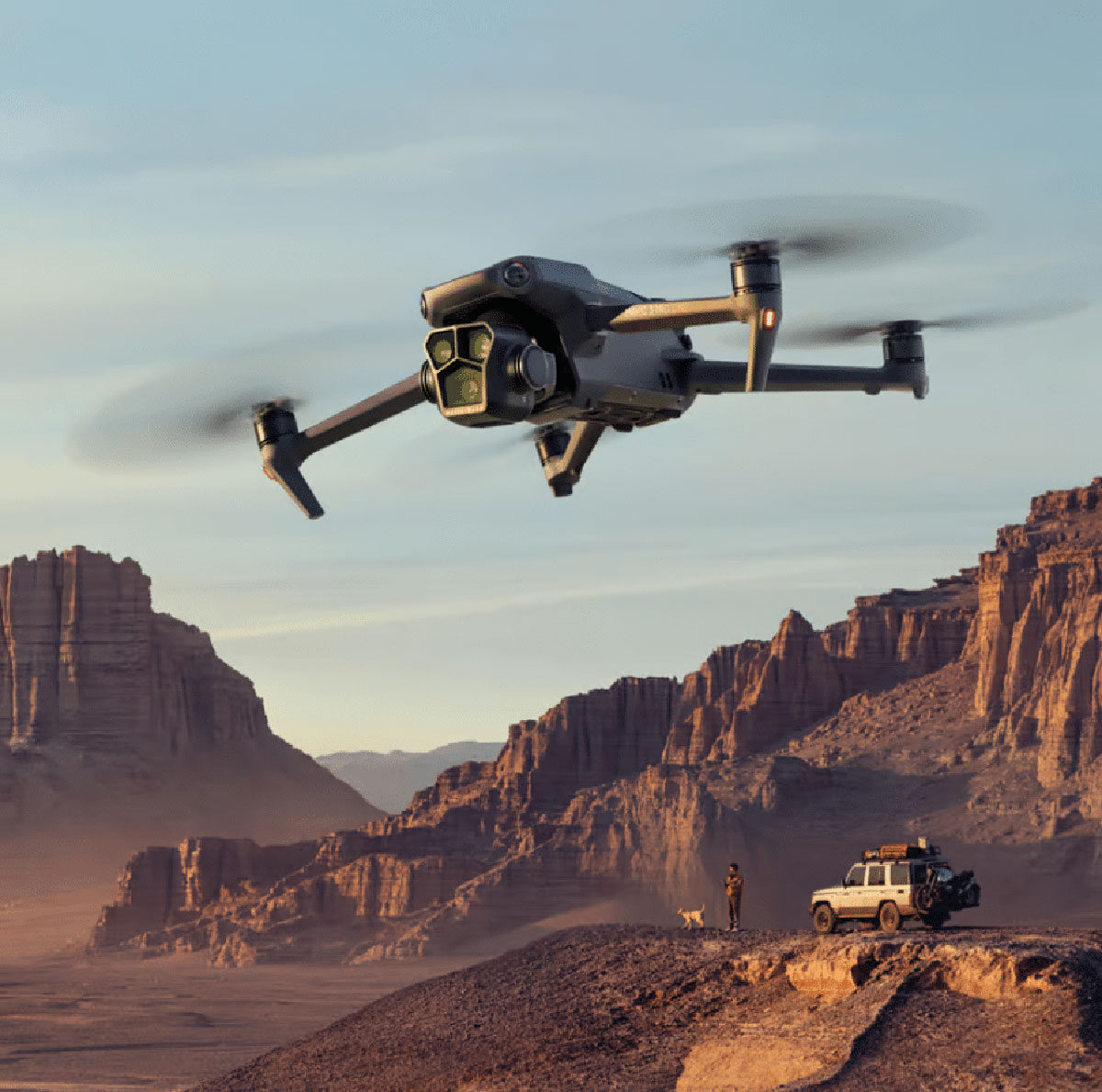5 Emerging Video Production Technologies to Watch
New Video Production Tools and Technologies To Look Out For.
15-minute read
The future of filmmaking is here, driven by revolutionary technologies that redefine how stories are told. As traditional techniques give way to innovation, filmmakers are crafting more immersive and visually stunning narratives than ever before. This shift invites creators to blend artistry with technology, with new and improved equipment. Here are five emerging video production technologies and trends that are reshaping the cinematic landscape.
In this article

Virtual Video Production
Virtual production represents a seismic shift in how films and television shows are created. This technique uses massive LED screens to create dynamic backdrops in real time, merging live-action performances with CGI elements. By eliminating the traditional reliance on green screens and extensive location shoots, virtual production allows actors to perform in environments that respond to their movements, creating a more authentic interaction with their surroundings.
One of the significant advantages of this approach is immediate feedback. Real-time rendering enables directors and cinematographers to see how lighting, shadows, and reflections interact with the set, facilitating on-the-fly adjustments that enhance visual storytelling. Additionally, this technique reduces the logistical challenges associated with location shoots, allowing filmmakers to transport audiences to far-off galaxies or ancient landscapes without extensive travel. This not only cuts production costs but also minimizes the environmental impact.
Moreover, virtual production fosters collaboration between different departments. Integrating production design, visual effects, and cinematography from the start cultivates a dynamic creative environment where ideas flow freely. As this technology evolves, it democratizes video production, allowing independent producers to create visually compelling content without massive budgets. This accessibility may lead to a surge of diverse stories and voices in the industry.
High Frame Rate Filming
Traditionally, films are shot at 24 frames per second (fps), a standard that has defined cinema for decades. However, high frame rate (HFR) filming, often at 48 fps or even 120 fps, represents a bold departure from this norm. HFR technology delivers smoother motion and reduces blurring during fast-paced scenes, creating a lifelike viewing experience, particularly in action sequences.
A notable example is Peter Jackson’s The Hobbit trilogy, filmed at 48 fps, which generated mixed reactions from audiences. While some viewers appreciated the clarity and realism it brought to the fantasy world, others found the effect jarring, sparking debate about HFR’s aesthetic implications. As filmmakers explore HFR, they venture into uncharted territory, examining how this heightened realism impacts viewer engagement and narrative dynamics.
The clarity HFR provides can enhance emotional resonance, allowing subtle facial expressions to shine through and inviting filmmakers to craft narratives that leverage this depth. Beyond feature films, HFR is gaining traction in virtual reality (VR) and gaming, blurring the lines between cinematic storytelling and interactive experiences. The exploration of HFR raises questions about the future of cinematic conventions: will traditional frame rates become obsolete, or will filmmakers find ways to integrate HFR selectively for maximum impact?
Light Field Cameras
Light field cameras represent a groundbreaking advancement in photography and video production, capturing the entire light field within a scene instead of just a single image. By recording light traveling in every direction, this technology provides video producers with unparalleled detail and flexibility in post-production, enabling adjustments to focus, depth of field, and even the creation of convincing three-dimensional effects after filming.
One of the key features of light field cameras is their ability to refocus images post-capture. This allows video producers to selectively determine which elements are in sharp focus and which are blurred, enhancing creative control and reducing the need for multiple takes. A single capture can yield various options for presenting a scene, streamlining workflows and saving time and resources.
Additionally, light field technology enables the creation of depth maps, simplifying the integration of 3D elements that traditionally required extensive rotoscoping and visual effects work. This innovation enhances visual storytelling, allowing video producers to experiment with dynamic visual effects that respond to changes in lighting and perspective.
In virtual reality (VR) and augmented reality (AR) applications, light field cameras are particularly beneficial, enhancing the immersive experience by allowing post-capture manipulation of depth and focus. As video production specialists explore the intersection of traditional production and immersive media, light field technology will play a crucial role in shaping future storytelling across platforms.
Moreover, as this technology becomes more accessible, it has the potential to democratize video production, empowering independent creators with tools once reserved for major studios. This shift can foster a wider diversity of voices and stories, enabling innovative narrative techniques without the constraints of traditional methods.
Drone Video Production & Cinematography
Drones have transformed aerial cinematography, making it accessible to filmmakers of all levels. By replacing costly helicopter rentals and complex crane setups, drones enable filmmakers to capture breathtaking visuals that enhance storytelling. Modern drones equipped with high-resolution cameras that shoot in 4K or higher provide exceptional image quality, capturing intricate details from high altitudes. Advanced stabilization technology ensures smooth, professional-looking footage even during rapid movements or turbulent conditions.
Drones allow for creative experimentation with shot compositions and movements. Their ability to fly low, ascend rapidly, or hover offers directors a variety of options for visual storytelling, enabling seamless transitions between aerial and ground-level perspectives. They are increasingly used in live events and sports broadcasting, providing real-time aerial coverage that enhances the viewing experience. This capability gives audiences a broader understanding of the action, whether at a concert, sporting event, or public gathering, adding excitement and dynamism to broadcasts.
However, the rise of drone usage in filmmaking has raised discussions about regulation and safety. As more filmmakers incorporate drones into their work, understanding the legal landscape surrounding drone video production is crucial for responsible video production and safety protocol adherence.
New Drones
- DJI Mavic 3 : Renowned for its portability and advanced imaging capabilities, the Mavic 3 features a dual-camera system, including a Hasselblad camera with a 4/3 CMOS sensor. This drone excels in capturing high-resolution footage in varying lighting conditions, making it ideal for filmmakers looking to achieve cinematic quality in diverse environments.
- Autel Robotics EVO Lite+ : This drone stands out with its impressive 50MP camera and the ability to shoot 6K video. Its long flight time and robust obstacle avoidance system make it a popular choice for video production workers who need reliability and advanced features for dynamic shots.
- Skydio 2 : Known for its autonomous flying capabilities, the Skydio 2 uses advanced AI to navigate complex environments, making it perfect for action-packed filming. This drone can follow subjects with remarkable precision, allowing video production workers to capture stunning chase sequences and dynamic movements without manual control.
- Freefly Alta 8 : Designed for professional filmmakers, the Alta 8 can carry heavy camera setups, including high-end cinema cameras like the RED Komodo or Arri Alexa Mini. This drone provides unmatched stability and versatility for producing high-quality aerial shots in a range of film genres.

Innovative Drone Techniques
- Follow Me Mode: Many modern drones come equipped with a “Follow Me” feature, which allows them to autonomously track and film a moving subject. This technique is particularly useful for action sports filmmakers, enabling them to capture immersive footage of athletes in motion without requiring a dedicated operator.
- Cinematic Reveal Shots: Drones can execute smooth, sweeping reveal shots that transition from a close-up of a subject to a wide aerial view, creating a dramatic effect. This technique is effective in storytelling, helping to establish context and enhance emotional resonance in video production.
- Orbits and Circles: By flying in a circular motion around a subject, drones can create dynamic, visually engaging shots that showcase both the subject and the surrounding environment. This technique is particularly effective in establishing shots, allowing viewers to appreciate the scale and context of the location.
- Aerial Time-Lapse: Drones can be used to create breathtaking time-lapse sequences that capture changes in the environment over time. By flying a predetermined path and taking photos at regular intervals, video production workers can create compelling visual narratives that highlight the passage of time in a unique way.
- Point of Interest (POI) Tracking: This technique allows the drone to circle around a specific point while maintaining focus on the subject. It is especially useful for capturing dynamic action or showcasing architectural features, as it provides a 360-degree tour of the scene.
- FPV (First-Person View) Filming: FPV drones allow video production workersto experience the flight from the pilot’s perspective, providing immersive footage that can convey excitement and speed. This technique is popular in action sequences and extreme sports, offering viewers a thrilling experience that traditional filming methods cannot replicate.
Immersive Audio Technologies
Advancements in audio technology, such as Dolby Atmos and DTS, have transformed how filmmakers create immersive soundscapes. This enhances emotional engagement, drawing viewers deeper into the narrative, particularly in genres like horror, sci-fi, and action. Dolby Atmos employs object-based audio, allowing sound designers to treat individual sounds as discrete elements that can move fluidly around the listener. This creates dynamic experiences, such as whispers passing behind viewers or the roar of a spaceship overhead, heightening emotional tension and immersion.
DTS offers similar flexibility, enabling soundscapes to react to on-screen action. In high-stakes scenes, orchestrated sounds of gunfire and explosions can envelop the viewer, amplifying excitement and urgency. Immersive audio also enriches other genres, as subtle ambient sounds in romantic dramas evoke emotions and establish a sense of place. As producers experiment with sound as a narrative device, they create opportunities for innovative storytelling.
With the rise of home theater systems, audiences can experience these advancements in their living rooms, encouraging filmmakers to explore new storytelling techniques across various settings—from cinemas to streaming platforms. The integration of immersive audio with virtual and augmented reality is also gaining traction, where accurate sound placement is crucial for maintaining immersion. As technology evolves, audiences can expect richer, more engaging experiences that resonate on emotional and sensory levels.
Conclusion
The convergence of technology and creativity is charting an exhilarating path for the future of filmmaking. These seven emerging technologies and trends represent just the beginning of a broader shift toward more immersive, interactive, and personalized cinematic experiences. As the tools of filmmaking become more accessible, diverse voices and stories can emerge, transforming the landscape of cinema.
This era invites filmmakers to experiment and push boundaries, crafting narratives that challenge conventions and engage audiences in new ways. We are not merely witnessing a transformation in storytelling; we are participating in the dawn of a new cinematic paradigm—one that promises to redefine how we experience film in the years to come.
Fullframe Creative provides a cutting-edge creative communication service: original concepts; clear, creative and concise content delivered competently.
In other words, we help you get your message across through the following tools and services:
- Video Production & Animation – corporate video, social media video, drone, interviews, interactive, video marketing, explainer videos, infographics, motion graphics and lots more.
- Digital & Social Media Marketing – digital concept development & strategy, web & interactive design, campaign strategy, design & management, copy & content writing, blogs & SEO.
- Virtual-hybrid Events & Tours / Video-conferencing – webinars, full event development & management, moderation & hosting, virtual visits.
- Media Training – public speaking & coaching, look & sound great on camera.
- Green-screen Production Studio – large video & photo production studio, 100% soundproof, professionally equipped 360° green-screen.
Fullframe has 15+ years of experience, 100+ satisfied customers and 1,000+ successful productions.
Spark up your Image!
Stand out for all the right reasons.
We help you communicate in a clear, creative and comprehensive manner.